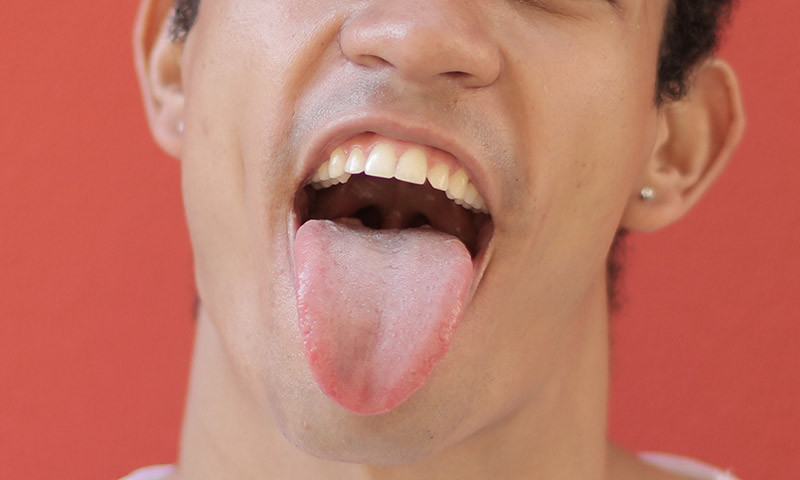Tongue function
The tongue is an incredibly diverse and fascinating organ. In addition to being a fundamental element of tasting and talking, your tongue plays a key role in digestion and immune system function. It moves solid food around your mouth and helps to break down food with saliva before you eventually swallow it. The rear of the tongue is home to defence cells that defend the body against germs.
Further, your tongue says a lot about your health in general. The presence of symptoms such as a coated or swollen tongue may be a sign of a health condition. For centuries, doctors and healers from both western and eastern cultures, including conventional western medicine, traditional Chinese medicine (TCM) and Ayurveda, have examined the tongue as a crucial component of physical check-ups, owing to its diagnostic significance.
Definition: What is a coated tongue?
What is the coating on your tongue exactly and what is it made up of? The surface of your tongue is covered with papillae. These contain thousands of taste buds that let us know whether food is sweet, salty, bitter or sour. When food debris, dead cells and bacteria or other germs become lodged on the papillae, the tongue starts to develop a whitish coating. The body's mucus plays a crucial role in holding everything together, while the papillae's rough surface supports its adherence to the surface of the tongue.
Is it normal to have a coated tongue?
A coated tongue in the morning or evening is completely normal and will automatically disappear with the correct oral and dental care. However, if the tongue is thickly coated or the colour of the coating is unpleasant, it may be a sign of a health condition.
Good to know:
Roughly 60 to 80 percent of the bacteria in your oral cavity can be found on the tongue. And that is the reason why you should always brush your tongue as well as your teeth – but never with the same toothbrush. As this would help the bacteria to spread across your teeth. Special tongue scrapers are available to ensure your tongue stays nice and clean.
What does a coated tongue look like?
A healthy tongue should be pale pink in appearance. Two images are presented here for comparison: The one on the left shows a coated tongue. While on the second image, the coating on the tongue has been removed. This type of white coating on the tongue is normal and can be removed with the correct oral and dental care.
Symptoms and causes: What does the colour of your tongue indicate?
It is therefore quite normal to have a slightly coated tongue. However, if the coating on the tongue proves to be particularly stubborn and cannot be removed with the correct oral and dental care, it may be a sign of an underlying health condition. Different coating colours indicate different health issues.
Whitish tongue coating
In the case of a white coated tongue, a distinction is made between coatings that can and cannot be removed. If the coating on the tongue can be easily scraped off using a tongue cleaner and the mucous membrane beneath looks normal, the tongue is healthy and there is basically nothing to worry about. However, if you are unable to remove the white coating or the mucous membrane below it appears red, it may be a sign of the following diseases:
Oral thrush
Oral thrush is a fungal infection of the mouth caused by a group of yeasts called Candida. People with a weak immune system are at an increased risk of developing oral thrush. Symptoms include white patches on the tongue that can often be wiped off easily. This leaves behind a red mucous membrane that may bleed slightly. Oral thrush can usually be treated successfully with anti-fungal medicines.
Common cold and influenza
A common cold can also cause your tongue to be thickly coated. The coating on the tongue is accompanied by common cold symptoms such as a cough, runny nose, fever, sore throat, difficulty swallowing and a headache and aching limbs. The coated tongue usually disappears as soon as your cold or flu symptoms clear up.
Tonsillitis
In addition to a whitish tongue, pus-filled spots on your tonsils are a symptom and sign of acute tonsillitis (angina tonsillaris). Further symptoms include swollen and painful glands in your neck and reddish discolouration of your mouth.
Digestive disorders
A white coated tongue can also indicate problems with the gastrointestinal tract, for example gastritis or irritable bowel syndrome. Accompanying symptoms include bloating, diarrhoea and constipation. Heartburn and reflux can also cause the tongue to be coated white – sometimes combined with earache, a reddish rash, sore throat and breathing difficulties.
If only the outermost sides of the tongue are coated and the middle part looks normal, you might have a problem with your pancreas.
Iron deficiency anaemia
A tongue that appears white without being coated could indicate iron deficiency and eventually lead to anaemia. In this case, the tongue looks more pale than actually coated. You may also notice that you have a pale complexion, if you have anaemia. Further symptoms include a lack of energy and difficulty concentrating.
Lichen planus
If white patches appear only underneath your tongue or on the insides of your cheeks, it may also be a sign of the autoimmune disease lichen planus. The cause is related to the immune system attacking cells of the skin or mucous membranes. Other symptoms of this disease include very itchy, angular-shaped patches on your skin. This autoimmune disease usually gets better with cortisone treatment in about 8 to 12 months.
Yellowish tongue coating
In the case of a yellow coating on the tongue, the intensity of the yellow is a crucial factor. A white-yellow or yellowish tongue can be a sign of a fungal infection in the mouth. In this case, the tongue often feels furry and you might have a strange, bitter taste in your mouth.
If the coating on the tongue is dark yellow in colour, it may be the result of a bile duct disorder or liver disease and should be assessed by a doctor. It could also be a sign of poisoning, for example.
A yellow coated tongue may also be attributed to an unhealthy lifestyle, which encompasses inadequate oral hygiene and the consumption of teeth-staining foods and drinks such as coffee and tea. Some people perceive their yellow tongue as an orange coating on the tongue.
Reddish tongue coating
If your tongue is no longer pale pink but bright red, it is most probably inflamed. This can be attributed to the following causes:
Scarlet fever
Besides a skin rash, fever, chills and a sore throat, a reddish coating on the tongue with swollen papillae – called raspberry or strawberry tongue – is a typical symptom of this bacterial disease. An interesting fact is that a white coating often appears on the tongue first before it turns red.
Glossitis
Inflammation of the tongue can also result in a reddish coating on the tongue. Possible causes may include:
- Bacterial infection
- Viral disease
- Food intolerances
- Regular consumption of alcohol and nicotine
- Poor diet
- Vitamin B12 deficiency
A painful, smooth and red tongue may be the first sign of vitamin B12–deficiency anaemia. A deficiency of iron and folic acid can also lead to a red tongue.
Kawasaki disease
Kawasaki disease is a condition that mainly affects young children and causes inflammation in the walls of small to medium-sized blood vessels. Similar to scarlet fever, it can be accompanied by a red raspberry tongue and fever.
Sjögren’s syndrome
The second most common autoimmune disease attacks the salivary glands. In addition to a dry mouth, a smooth red tongue – also known as bald tongue – is a typical symptom.
Brownish tongue coating
A brown coated tongue can be a sign of an intestinal upset or even problems with your kidneys. But heavy smoking, certain medications or excessive use of mouthwash with chlorhexidine can also be responsible for the brownish appearance.
Greenish tongue coating
A green coated tongue usually has nothing to do with a health issue. If you have a green coating on your tongue, it is probably because you have eaten some green herbs such as parsley. A yellow coating on your tongue may be perceived by some people as green discolouration.
Bluish tongue coating
If you have a blue coating on your tongue but otherwise feel fine, the cause can possibly be attributed to eating blueberries or drinking a glass of red wine. But insufficient oxygen in the blood, often resulting from severe lung or heart disease, can also lead to a purple-blue coating on your tongue.
Greyish tongue coating
If you have a grey coating on your tongue, it can be a sign of an iron deficiency or anaemia. But it could also be the symptom of a stomach ulcer or a dysfunctional spleen.
If you have a thick greyish-white coating on the middle of your tongue, while the edges are red, and you are also suffering from constipation, diarrhoea or a skin rash, it is best to consult a health care professional. You could be showing symptoms of the bacterial infectious disease typhus.
Blackish tongue coating
A black coated tongue is also referred to as black hair tongue, as the elongated papillae at the back of the tongue look like tiny black hairs. The black coating on the tongue can be a side effect of taking antibiotics or the symptom of an immune system disease. A black coated tongue can, in rare cases, also be the result of a fungal or bacterial infection or poor oral hygiene.
Other oral symptoms
A coated tongue does not usually occur by itself. It is often accompanied by other oral symptoms:
Blisters, spots or red dots
Sore patches in your mouth that look like blisters, spots or red dots could be aphthae. These small lesions of the oral mucous membranes are often very painful and can appear all around the mouth – including on the tongue. They are harmless and usually clear up by themselves. Most pharmacies stock treatments that speed up the healing process.
Possible causes of aphthae:
- Lesions of the oral mucous membranes (for example biting your tongue or damaging your gums with a toothbrush)
- Stressful situations
- Unhealthy diet
- Iron deficiency
- Gastrointestinal disease
- Vitamin B12 deficiency
- Viruses
- Medications
Burning mouth syndrome
Women are more likely than men to suffer from burning mouth syndrome – especially during menopause. Usually the tip of the tongue and the lower edge of the tongue are affected. Some people suffer from burning mouth syndrome every day; in others, the pain occurs only occasionally and often reaches a peak in the evenings. The disorder is characterised by burning and other irritations like itching. A common cause of burning mouth syndrome is a deficiency of vitamin B6, vitamin B12, iron or folic acid. People with gluten intolerance are more prone to burning mouth syndrome and it can also be a sign of an allergy.
Swollen tongue
A swollen and coated tongue is often a sign of glossitis (see above), but can also be a side effect of heartburn medication. If your tongue swells up rapidly and you are having difficulty breathing, you should consult a health care professional immediately. This could be an allergic reaction to an insect bite or something you have eaten. In the worst case, the swelling starts to expand to the back of the throat and affects your ability to breathe.
Sore or rough tongue
The normal slightly rough surface of the tongue is due to the papillae. In fact, it is somewhat worrying if the tongue is completely smooth. However, if your tongue feels very "bumpy" and painful, this could be a response to inflammation and injury of the mucous membrane. Perhaps you have accidentally bit your tongue or burned your mouth with a hot drink.
Geographic tongue
Geographic tongue is a condition that creates a white coating in combination with grooves and blotchy, red patches on your tongue that resemble land masses and oceans on a map. Despite looking strange, a geographic tongue is harmless.
Coated itchy tongue
If your tongue swells up rapidly, itches and tingles after drinking or eating something cold, it might be a sign of a reaction to cold stimulus (cold urticaria). This condition is triggered by exposure to low temperatures.
Fissured tongue
If there are deep cracks on the top surface of your tongue, you should see a health care professional, as the bacteria on your tongue can accumulate quickly and cause infection. A fissured tongue may be a sign of chronic intestinal problems that are causing deficiencies of vitamins and trace elements.
Blotches
If white patches that cannot be rubbed or scraped away appear underneath your tongue, on your gums or the edge of your tongue, it may be a sign of leukoplakia. The oral mucous membranes produce more horny cells than usual. There is a risk that leukoplakia could progress to mouth cancer over time. These patches often turn into malignant tumours. Leukoplakia is usually caused by smoking.
A special form of leukoplakia is oral hairy leukoplakia: A condition triggered by the Epstein-Barr virus that causes white patches to appear on your tongue. It happens most often in people with HIV or other immunodeficiency diseases.
Bad breath
Unfortunately, a coated tongue not only looks unattractive, it also often goes hand in hand with bad breath – especially if the cause of the coated tongue is poor oral hygiene. But inflammation, fungal infections and dry mouth can also lead to a malodour.
Good to know:
In roughly 90 percent of cases, bad breath is caused by bacteria in the oral cavity and can be eliminated by paying particular attention to good oral and dental hygiene.
Dry mouth
If you generally suffer from a dry mouth, you are more likely to have a coated tongue. Since the protective power of your saliva is reduced, bacteria can spread rapidly in your oral cavity – including on your tongue. Besides being coated white, your tongue may often feel furry, accompanied by a peculiar taste in your mouth or an altered taste sensation.
Other causes of a coated tongue
A coated tongue is not necessarily a sign of a physical illness. A thin coating is quite normal but certain factors may exacerbate its impact. Below is an overview of some other causes:
Psyche
A coated tongue can also be caused by psychological factors and is more common in people suffering from depression. Stress or trauma may also be the reason for the condition.
Side effect of medications or therapy
A coated tongue can be experienced as a side effect of certain medications or due to surgery:
- Surgical procedures in the oral cavity (for example dental operations, wisdom tooth removal, tooth extraction, tonsil operation)
- Cancer treatment (chemotherapy)
- After a course of antibiotics (for example Amoxicillin)
- Use of asthma sprays containing cortisone (after use, it is best to rinse your mouth well or brush your teeth)
Food
You may develop a white coating on your tongue after eating certain foods, especially if you are intolerant to that food group.
- Sugary or acidic foods
- Gluten-containing foods (especially if you suffer from gluten intolerance/coeliac disease)
- Dairy products such as yoghurt if you are lactose intolerant
Lifestyle
A heavily coated tongue is usually the result of a certain lifestyle.
Do any of these factors apply to you?
- You do not drink enough (less than 1.5 litres a day).
- You drink alcohol regularly (for example beer).
- You drink a lot of coffee or tea.
- You smoke.
Poor oral hygiene
A harmless coating on the tongue, consisting of food debris, bacteria and dead cells, usually disappears with proper oral hygiene. However, if you frequently skip brushing your teeth, the coating on your tongue will get thicker. And too much bacteria in your mouth can quickly lead to bad breath.
Tongue piercings
A coating often appears on newly pierced tongues. This is a completely normal bodily reaction and usually disappears within two to three weeks. Further, tongue piercings can become infected due to the amount of bacteria in your mouth. A coated tongue is then a symptom of the tongue infection.
Fasting
When you chew food, it passes through your mouth and over your tongue. This helps to remove the normal coating from your tongue. However, when fasting, you only consume food in liquid form, meaning the coating is not removed and your tongue remains coated. That is why it is a good idea to use a tongue scraper as part of your fasting routine.
Good to know:
The best way to get rid of bacteria is to brush your teeth at least twice a day for two to three minutes – ideally in the morning after breakfast and at night before going to bed. Correct oral and dental care includes cleaning the spaces between your teeth carefully with an interdental brush.
Coated tongue in various stages of life
The presence of a coating on your tongue is related to several factors that change throughout our lives. In infancy, our immune system is relatively immature; during pregnancy and menopause, our hormones go haywire; and in old age, we have trouble chewing properly.
Coated tongue in babies and children
In babies, a coated tongue – especially if the coating is white and a bit like cottage cheese and also occurs on the inside of the cheeks – is often a sign of oral thrush (see above). This fungal infection is particularly common in babies, as their mouths still lack the required diversity of healthy germs and fungi can spread rapidly. The tongue might also be coated during the teething period.
Oral thrush is less common in older children and typically only occurs when their immune systems are compromised or they have been taking antibiotics or cortisone for a longer period. A whitish tongue in children is usually a symptom of a simple cold.
Coated tongue during pregnancy
Dry mouth is also a very common symptom of pregnancy. Changing levels of hormones can reduce the production of saliva, resulting in a dry mouth, which can lead to an increase in bacterial growth in the oral cavity and consequently a thicker coating on your tongue. Furthermore, during pregnancy, women need to be drinking for two and thus regularly become dehydrated.
Coated tongue during menopause
Changing levels of hormones also impact the salivary glands during menopause. In addition to a coated tongue, many women complain of dry mouth and burning mouth syndrome (see above). Quite often a vitamin deficiency (vitamin B12) is the cause.
Coated tongue in old age
Since older people tend to eat soft foods and mobility of the tongue is limited, the coating is no longer removed naturally from the tongue. It can therefore build up over time. In this case, it is a good idea to use a tongue scraper.
Which health care professional should you see about a coated tongue?
If the coating on your tongue is worrying you, it is best to consult a health care professional to rule out any serious health conditions. But which health care professional is the right person to visit about a coated tongue and when should you go?
Here is a piece of general medical advice: If the problem has not cleared up after two weeks or you are worried about it, go and see a doctor.
You have two options in this case:
- General practitioner (GP) (about a coated tongue without any problems with your teeth or gums)
- Dentist (about a coated tongue with associated problems such as toothache or gum disease)
Your GP will then order further tests if necessary, such as a blood test, MRI or gastroscopy. A swab will be used to collect some coating from your tongue – this sample will then be examined for a fungal infection (Candida), bacteria or viruses.
When should you consult a health care professional about a coated tongue?
A thin, whitish coating on your tongue is normal and usually disappears during the day. But how can you tell if you should go and see a doctor?
If any of the following factors apply to you, then you should get your tongue looked at by a health care professional:
- You have further symptoms like pain or burning mouth syndrome.
- The coating on your tongue has a strange colour.
- The coating is still on your tongue after two weeks.
- Your tongue itches and is getting worse rather than better.
- You have a fever and feel ill.
- The coating on your tongue has changed significantly.
- There is a sensation of a foreign body or a feeling of numbness.
- You are experiencing a loss or a change in taste.
Do the symptoms of a coated tongue disappear on their own?
A harmless, white coating on your tongue is normal and usually disappears on its own. However, if the coating on your tongue is a different colour, very thick or is still there after two weeks, you should go and see a doctor about it.
Treatment: How to get rid of a coated tongue
The best treatment for a coated tongue depends on its cause. If the infection is viral, fungal or bacterial, your GP will prescribe the appropriate medication (with either antiviral, antifungal or antibiotic properties).
Cleaning your tongue can effectively eliminate the harmless white coating, which may be more or less prevalent in different individuals on a daily basis.
How to remove the coating from your tongue
The best and easiest way to remove the coating from your tongue is with a tongue scraper. The practice involves scraping the tongue from back to front several times using light pressure. Proceed systematically from one side to the next. Afterwards, simply rinse your mouth with water or a mouthwash. Rinse the scraper under running water after use and allow it to dry.
Incorporating tongue cleaning into your daily oral hygiene routine is recommended – particularly if your tongue tends to be heavily coated. This is a great way to get rid of the coating and any oral malodour.
And if you do not have a tongue scraper to hand, simply clean the coated tongue with a toothbrush. But beware! Never use the same toothbrush to clean your teeth! As this would help the bacteria from your tongue spread across your teeth, thus providing a new surface for the bacteria to grow and multiply on.
Good to know:
Curaprox tongue scrapers have the ideal anatomic shape. Allowing you to clean your tongue easily without having to gag. The double-arched model ensures the thorough removal of bacteria and is highly effective against halitosis. Discover how to use the tongue scraper correctly here:
Tongue cleaner - How to use the tongue scraper correctly
Best remedies for a coated tongue
After removing the coating from your tongue, the following remedies really help:
Home remedies
The best home remedy is a healthy diet with lots of fruit and vegetables. Thoroughly chewing solid food, like a crunchy apple or raw carrot, automatically scrapes the coating off your tongue. Further, chewing helps to stimulate the flow of saliva. More saliva automatically equals less coating on your tongue, as it naturally disrupts the spread of bacteria, viruses and germs.
Chewing gum
Chewing gum also stimulates saliva production and is a great way to combat a coated tongue and bad breath. Unwanted bacteria are flushed away by the saliva. Nice side effect: Other unpleasant problems associated with a coated tongue, such as a furry feeling and peculiar taste, can be transformed into a pleasant sensation of freshness.
Important: Remember to always use sugar-free chewing gum. Chewing gums with xylitol are particularly suitable. The natural sweetener protects your teeth from dental decay by ensuring the bacteria in your mouth no longer convert sugar into acid.
Good to know:
‘Black is White’ chewing gum from Curaprox not only stimulates saliva production, thereby helping to remove the coating from your tongue, the activated charcoal also gently whitens your teeth! In addition, xylitol ensures a pleasant sweet taste and excellent protection against dental decay.
Mouthwash
Mouthwashes of the Curaprox Perio plus series are a highly effective way to combat germs in the oral cavity and on the tongue, thus helping to prevent infections. But beware! A mouthwash alone is not the ideal treatment for a coated tongue. Initially use a tongue scraper to remove the coating and then rinse your mouth thoroughly with a mouthwash.
Tips for a healthy tongue
Here are a few tips that can be easily integrated into your daily routine to prevent you getting a coated tongue in the first place:
- Drink enough (at least 1.5 litres a day – preferably water or unsweetened teas)
- Chew solid food properly and eat lots of fruit and vegetables (preferably raw to ensure the crisp edges scrape off the coating naturally)
- Stop smoking (to avoid illnesses such as leukoplakia and yellow discolouration)
- Reduce your intake of coffee and alcohol
- Check your tongue regularly to see if it is coated (preferably first thing in the morning)
The correct oral and dental care to treat a coated tongue
A coated tongue is usually caused by a build-up of dead cells, food debris and germs. Bacteria, viruses and fungi can nestle between the papillae on the rough surface of your tongue and multiply with ease. To prevent this from happening, you should pay particular attention to thorough oral and dental hygiene. This helps to prevent a thick coating settling on your tongue in the first place.
Cleaning teeth
To stop germs spreading rapidly on your tongue and in your oral cavity, you should brush your teeth at least twice a day for two to three minutes – ideally in the morning after breakfast and at night before going to bed. It is best to use a soft toothbrush and a saliva-stimulating toothpaste, such as the toothpastes of the Curaprox Enzycal series – they contain three enzymes that are also found in saliva and offer excellent protection against dental decay. More saliva means less coating. Saliva helps to flush bacteria, germs and fungi out of your oral cavity.
Good to know:
Did you know that aggressively brushing your teeth is a complete waste of time? Instead of applying a lot of force, it is better to use a correct and gentle brushing technique. Discover the best brushing technique to protect your teeth below:
Cleaning the spaces between your teeth
Only two-thirds of a proper dental cleaning routine can be accomplished with a standard toothbrush. The spaces between your teeth are a real breeding ground for bacteria and impossible to get to with a conventional toothbrush. These hard-to-reach gaps can only be cleaned correctly with an interdental brush.
Using a tongue scraper
The best way to combat a coated tongue is to prevent it from happening in the first place. A harmless coating on your tongue can be removed in a matter of seconds each day using the Curaprox tongue scrapers – without any gagging.
Sources
Apotheken.de: Patienteninformation für "Pantoprazol“.
AOK Gesundheitsmagazin: Veränderungen der Zunge: harmlos oder Krankheitszeichen?.
DexiMed: Lichen ruber planus (Knötchenflechte).
gesundheit.de: Belegte Zunge.
gesundheit.de: Brennende Zunge: Was kann dahinterstecken?.
Hennessy, Bernard J.: Verfärbungen der Zunge und andere Veränderungen, in: MSD Manual. Ausgabe für medizinische Fachkreise.
Hoffschulte, Karen: Zungen- und Pulsdiagnostik, at: carstens-stiftung.de.
HNO Privatpraxis Ulm: Mundtrockenheit und Zungenbrennen.
HNO Biberach: Mandelentzündung.
Hull-Deichsel, Natalie: Kälteallergie: Juckende Zunge ist ein Symptom, at: 24vita.de.
Klinikum Stuttgart: Kawasaki-Syndrom.
Kinder- & Jugendärzte im Netz: Was ist Mundsoor?.
kry: Belegte Zunge: Was ist gesund?.
Lanza, Florian /Lechthaler, Maja: Zungenbelag: Zungenbelag, at: mooci.org.
Mandel, Tina: Zungenbelag, tiefe Furchen und Co. – Deine Zunge der Krankheiten-Detektor, at: dr-dentina.de.
Müller-Hotop, Thomas: Belegte Zunge, at: ecdi.de.
Münster, Tobias: Die Zunge – der Spiegel des Körpers, at: allgemeinaerzte-schwarzenbruck.de.
Neumann, Angela: Laktose-Intoleranz erkennen und behandeln, at: menshealth.de.
NetDoktor: Zungenkrebs.
Nittka, Verana et al.: Scharlach - wenn die Zunge himbeerrot wird, at: tk.de.
Rutkowski, Hanna: Belegte Zunge, at: netdoktor.de.
Seidel, Frank: Zungenbelag - Ursachen, at: zahnarzt-drseidel.de.
Singer, Sophie: Belegte Zunge: Diese Hausmittel helfen bei einer weißen Zunge, at: utopia.de.
All websites last accessed on 10 March 2023.
 Swiss premium oral care
Swiss premium oral care








